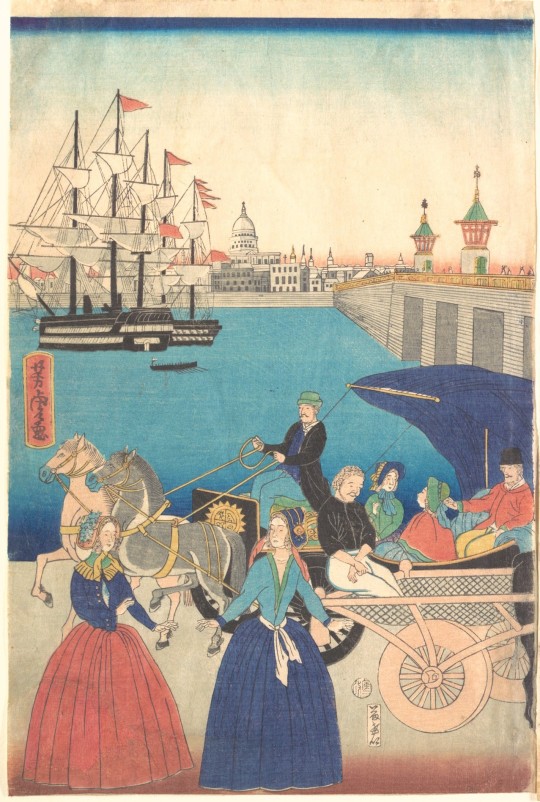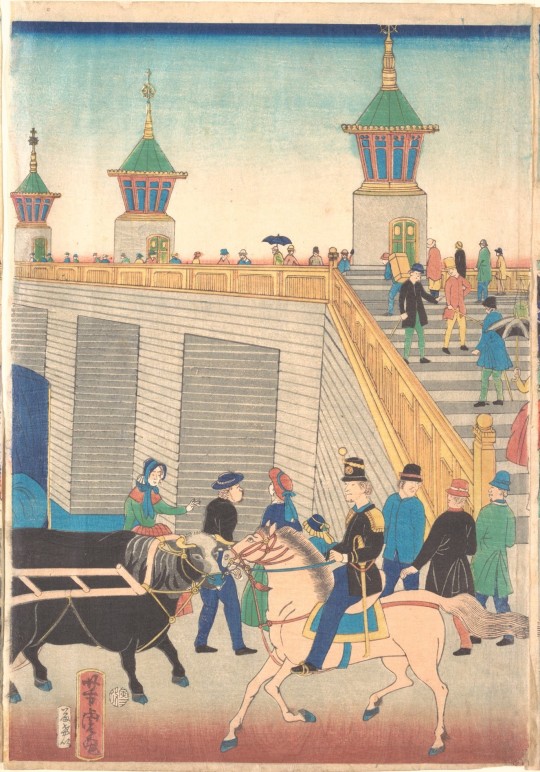#yoshitora utagawa
Explore tagged Tumblr posts
Text

"BOY, WHERE'S THE FIRE?" -- HOW TO SIGNIFY A FIREFIGHT IN THE EDO PERIOD.
Artist: Utagawa Yoshitora.
Title: The Flowers of Edo Children's Amusement; Fireman, First Squad, "Yo" Brigade.
Date: c. 1858
Details: ARC Ukiyo-e Database
Source: The Metropolitan Museum of Art, USA.
Source: https://ukiyo-e.org/image/met/DP148993.
#Edo Fireman#Edo#Edo Period#Edo Japan#Yoshitora Utagawa#Utagawa Yoshitora#Met#The Met Museum#Metropolitan Museum of Art#Met Museum#The Met#Japanese Woodblock#The Flowers of Edo Children's Amusements#Yoshitora Utagawa Artist#Yoshitora Utagawa Art#Japanese Woodblock Art Print#Matoi#Japanese#Flowers of Edo#Japanese Art#Japanese Style#Japan#Utagawa Yoshitora Art#Edo Japan Art#Japanese Firemen#Edo Firemen#Art Print#Japanese Art Print#Utagawa Yoshitora Artist#The Metropolitan Museum of Art
12 notes
·
View notes
Photo
I'd love to know if the specific depictions have any basis in Japanese folklore or literature or any exaggerated accounts of real events in America or American folklore.

– John Adams Fighting a Giant Snake
Source: Osanaetoki Bankokubanashi (童絵解万国噺), pub. 1861
From the 1630s to the 1850s under the Tokugawa Shogunate, Japan had implemented a strict ‘closed country’ policy, sakoku (鎖国), where trade with other countries was severely limited (mostly Dutch & Chinese traders) and a majority of the country had never met a foreigner in their lives. The policy ended in 1854 when under the orders of President Millard Fillmore, Commodore Matthew C. Perry arrived & after a series of visits (and under “threat of force”) Japan signed the Kanagawa Treaty to establish a trade relationship with the U.S.
As the country was increasingly exposed to outside cultures like America, many artisans began to create historical (as well as historical fiction) accounts of some of the stories they had heard & from imported books they had read. One such book, telling a very different story of the American Revolution, is Osanaetoki Bankokubanashi (童絵解万国噺), written by Robun Kanagaki & published in 1861, with art by Yoshitora Utagawa
133 notes
·
View notes
Text

A Japanese Illustrated History of America (1861), pictured: George Washington punching a tiger.
#art#Japanese history#Kanagaki Robun (仮名垣魯文)#Utagawa Yoshitora (歌川芳虎)#Osanaetoki Bankokubanashi (童絵解万国噺)
36 notes
·
View notes
Text

The Fox-Wedding Procession by Utagawa Yoshitora (1860)
#utagawa yoshitora#art#ukiyo-e#woodblock prints#fine art#19th century#19th century art#edo era#edo period#woodblock print#japanese art#japanese artist#japanese folklore#foxes#kitsune#wedding#asian art#classic art
400 notes
·
View notes
Text

Utagawa Yoshitora
Founding of Miyajima
Circa 1850
#utagawa yoshitora#woodcut#japanese woodblock print#japan#japanese art#asian art#art history#japanese prints#aesthetictumblr#tumblraesthetic#tumblrpic#tumblrpictures#tumblr art#japanese beauty#beauty#tumblrstyle#artists on tumblr#tumblrposts#aesthetic#japanese aesthetic#asian aesthetic#modern art
132 notes
·
View notes
Text

In the Western Sea, The Diving Women See the Ghosts of the Heike Clan Deep Under the Water by Utagawa Yoshitora (1843-47)
* * * *
“One need not be a chamber to be haunted, One need not be a house; The brain has corridors surpassing Material place.
Far safer, of a midnight meeting External ghost, Than an interior confronting That whiter host.
Far safer through an Abbey gallop, The stones achase, Than, moonless, one's own self encounter In lonesome place.
Ourself, behind ourself concealed, Should startle most; Assassin, hid in our apartment, Be horror's least.
The prudent carries a revolver, He bolts the door, O'erlooking a superior spectre More near.” ― Emily Dickinson, The Complete Poems of Emily Dickinson
11 notes
·
View notes
Text

The Hag of Hell (Datsueba) and Her Worshippers, 1849
by Utagawa Yoshitora
3 notes
·
View notes
Text

The Battle of Onin during the Onin War (1467-1477) by Utagawa Yoshitora.
0 notes
Text

Cherry Blossom (from the series 'Modern Flower Notes') Utagawa Yoshitora (active 1837–1887) Bristol Museum & Art Gallery
45 notes
·
View notes
Text



A triptych woodblock print depicting London in 1866, as imagined by Japanese artist Utagawa Yoshitora
#it's got St. Paul's in there whattayawant#london#intersectionality#victorians#19th century#art history
104 notes
·
View notes
Text

Notes on Sericulture by Utagawa Yoshitora, 19th century, Japan.
73 notes
·
View notes
Text



THE ART OF FIREFIGHTING IN THE EDO PERIOD.
PIC(S) INFO: Mega spotlight on a Japanese woodblock print of Edo Fireman with matoi standard, c. 1860, artwork by Yoshitora Utagawa (active circa 1840 - 1880).
OVERVIEW: "A great design from Yoshitora's series "The Flowers of Edo Children's Amusements," a 64 print series depicting each of the 64 fire brigades in Edo. The term "Flowers of Edo" in the title here refers to fires. Each print features a portrait of a fireman holding his company's unique matoi, a fringed standard used to signal the location of a fire. Each wears a quilted jacket that could be wetted before firefighting for protection. A rarely seen series depicting these heroic firefighters."
-- FUJI ARTS (Japanese Art Print Auction house)
Source: www.fujiarts.com/edo-era-japanese-prints/yoshitora/951343-edo-fireman-with-standard-1860.
#Japanese Woodblock#Japanese Fireman#Edo#The Flowers of Edo Children's Amusements#Yoshitora Utagawa Artist#Yoshitora Utagawa Art#Japanese Woodblock Art Prints#Edo Period#Edo Japan#Flowers of Edo#Japanese Art#Japanese Art Prints#Utagawa Yoshitora Artist#Utagawa Yoshitora Art#Japanese Firemen#Edo Fireman#Edo Firemen#Utagawa Yoshitora#Flowers of Edo for Children’s Amusement#Flowers of Edo Fun for Children#Edo Firefighter#Edo Firefighters#Yoshitora Utagawa#Matoi#Woodblock Print#Art Prints#Japanese Style#Japanese Art Print#The Flowers of Edo#Japanese Woodblock Art Print
7 notes
·
View notes
Photo

Japanese warlord Tachibana Muneshige, by Utagawa Yoshitora
241 notes
·
View notes
Text

"Concubine Gozen Tomoe" by Utagawa Yoshitora Ichimosai (1850-1880)
4 notes
·
View notes
Text

Utagawa Kuniyoshi ,'The Habit of Reading Books'..."Utagawa Kuniyoshi (Japanese: 歌川 国芳, [ɯtaɡawa kɯɲiꜜjoɕi]; 1 January 1798 – 14 April 1861) was one of the last great masters of the Japanese ukiyo-e style of woodblock prints and painting. He was a member of the Utagawa school. The range of Kuniyoshi's subjects included many genres: landscapes, women, Kabuki actors, cats, and mythical animals. He is known for depictions of the battles of legendary samurai heroes. His artwork incorporated aspects of Western representation in landscape painting and caricature...
Kuniyoshi was an excellent teacher and had numerous pupils who continued his branch of the Utagawa school. Among the most notable were Yoshitoshi, Yoshitora, Yoshiiku, Yoshikazu, Yoshitsuya, and Yoshifuji. Typically his students began an apprenticeship in which they worked primarily on musha-e in a style similar to that of their master. As they became established as independent artists, many went on to develop highly innovative styles of their own. His most important student was Yoshitoshi, who is now regarded as the "last master" of the Japanese woodblock print. Among those influenced by Kuniyoshi was Toyohara Chikanobu.[7] Takashi Murakami credits the pioneering influence of Kuniyoshi affecting his work.
3 notes
·
View notes
Text





47 samurai 四十七士, shijūshichishi
also known as Akō incident (赤穂事件, Akō jiken)
A historical event in which 47 rōnin avenged the loss of their master on January 31, 1703, fully aware of their consecutive death. A legendary moral example of integrity and respect to the samurai principles.
Asano Naganori lord of Akō (now in Hyōgo prefecture) was invited to Edo (now Tokyo) as the 4th member of the official reception group for imperial envoys arriving from Kyōto, during shogun Tokugawa Tsunayoshi's rule. Kira Yoshinaka, retainer of the shogun, had the duty to inform them about the court etiquette.
Kira, annoyed by lord Asano's lack of manners (he didn't offer Kira some informal but hefty bribe/prasent), became insultingly rude. Asano lost his temper, drew his sword and inflicted Kira a minor facial wound, but a sword drawn inside the shogunate was a grave breach of protocol and Asano had to commit ritual suicide at once.
The forty-seven samurai of Asano's bodyguard, reduced to ronin, decided that their code of honour demanded revenge. Taking to ostentatious idleness and dissipation to put both Kira and the authorities off guard, they waited for almost two years. While the oldest, who was in his eighties, was excluded from the attack as witness and messenger of the events, on the night of January 30, 1703, they attacked Kira’s mansion, killed several of Kira's samurai, found him scared shirtless hiding in a closet and decapitated him.
The avengers washed and carried the head to Sengakuji Temple and put it on their lord's grave.
To this day, the story remains popular in Japan, and each year on 14 December, the temple where Asano Naganori and the rōnin are buried, holds a commemorative festival.
Fictionalised accounts of the tale of the forty-seven rōnin are known as Chūshingura. The story was popularised in numerous plays, including in the genres of bunraku and kabuki. Because of the censorship laws of the shogunate in the Genrokuera, which forbade portrayal of current events, the names were changed. The first Chūshingura was written some 50 years after the event.
Utagawa Yoshitora: 47 (45) Ronin Portraits, ca 1840. Ukiyo-e
https://www.britannica.com/event/47-ronin
https://en.wikipedia.org/wiki/Forty-seven_r%C5%8Dnin
https://www.historytoday.com/archive/months-past/forty-seven-ronin-incident
6 notes
·
View notes